Thursday, February 7, 2013
Moving Day!
My daughter has been setting up a new site for me that will have fewer problems with fonts and other issues. All previous posts will stay here, but will also appear, along with all new posts, at www.conservationbigyear.com
Species of Concern: Loggerhead Shrike
 |
| Loggerhead Shrike |
When I bird in Florida, I’m ever scanning fence posts and
power lines in hopes of seeing Loggerhead Shrikes.
Shrikes are predacious
songbirds, but that’s not very exceptional—so are chickadees, robins, and
bluebirds, the insects and worms they eat being very much animals. Shrikes feed
on small lizards, birds, and mammals as well as insects, but so do some crows,
ravens, and even large flycatchers. The difference is that shrikes eat meat
almost exclusively, with physical and behavioral adaptations unique among
songbirds. The hooked beak tip and sharp notch near the tip help grab and sever
the spinal cord of small vertebrates. When a shrike bites off more than it can
chew in one meal, so to speak, it can impale whole prey or parts on thorns or
barbed wire, or wedge it into the fork of a branch, both for easier killing and
for longer-term storage. This habit led to the family nickname, “butcherbirds.”
The proportionally large head of all shrikes is particularly highlighted in the
Loggerhead Shrike’s name, a synonym for “blockhead.” Of the 30 or so species in
the family, only the Loggerhead is entirely restricted to North America. It’s a
little smaller and daintier than the Northern Shrikes we see up here in winter.
And Loggerhead Shrikes eat fewer rodents and birds, focusing heavily on
grasshoppers.
 |
| Loggerhead Shrike eating grasshopper |
Loggerhead Shrikes used to be fairly regularly seen in
southern Wisconsin and Minnesota, but they declined drastically through the
last half of the twentieth century. They’ve essentially vanished from the
northeastern part of their range and continue to decline everywhere else. The
subspecies on San Clemente Island in California is listed as endangered on the
federal list.
 |
| Breeding Bird Survey numbers: Loggerhead Shrike decline in Wisconsin |
 |
| Breeding Bird Survey numbers: Loggerhead Shrike decline in Minnesota |
I’ve visited Florida almost every year since our son Joe
moved there in 2003. I have a much harder time finding them now than I used to
down there, and the steep decline shown in Breeding Bird Survey numbers for
Loggerhead Shrikes in Florida between 1966 and 2010 bears graphic testament to
my experience. I find it endlessly frustrating that despite the dramatic
decline virtually everywhere, they aren’t on the federal list for endangered,
or at least threatened, species.
 |
| Breeding Bird Survey numbers: Loggerhead Shrike decline in Florida |
 |
| Breeding Bird Survey numbers: Loggerhead Shrike decline in United States |
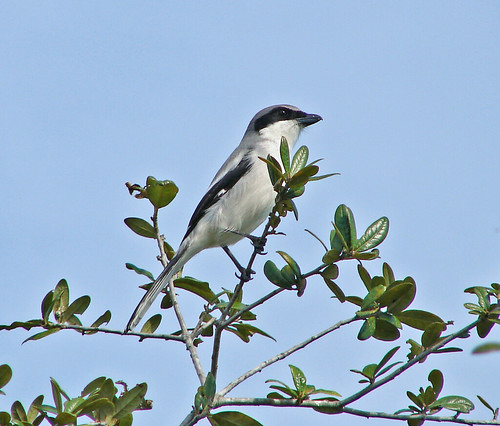 |
| Russ and I watched this breeding Loggerhead Shrike at a Nature Conservancy/Disney property in Florida in 2005. |
Overall, Loggerhead Shrikes seem a little calmer in the
presence of gawking birders than Northern Shrikes usually are, but even they
are a bit skittish. In January I came upon one while on a pleasant drive from
Titusville to New Smyrna Beach in Florida. It had caught a large grasshopper
and was starting to eat it. I stopped momentarily when I spotted it and snapped
a few photos from my car window, but I did not want to risk frightening off the
little predator, especially since he might have lost the morsel, so I drove on.
We humans haven’t left them much space and our pesticides kill many of their prey,
but these handsome songbirds deserve our respect and affection.
 |
| Loggerhead Shrike with grasshopper |
Monday, February 4, 2013
February 3: Superb Owl Sunday
 |
Several years ago, I realized that by just adding a properly
placed space, I could transform Super Bowl Sunday into Superb Owl Sunday. Last
year Russ and I were in New York City visiting our daughter Katie and her S.O. Michael
on the big day. We decided to head out to Breezy Point Tip on the city’s ocean
front to at least get out into the wild for a while, when what to our wondering
eyes should appear but two Snowy Owls! One was a very mature adult male, his
plumage snow white. I’ll never forget that thrilling and unforgettable day,
even richer for sharing it with my family.
 |
| Snowy Owl in NYC on Superb Owl Sunday, 2012, not enlarged or cropped |
 |
| That Snowy Owl after cropping |
This year I was certain things couldn’t possibly go that well ever again on
Superb Owl Sunday, but figured I might be able to see an owl somewhere. During the past two weeks, Boreal Owls have been appearing
all over between Duluth and Two Harbors, and a few weeks ago, Ryan Brady even
had one in his yard in Washburn, Wisconsin, and so birders from all over the
country are descending upon Duluth to see them. Boreal Owls periodically
“irrupt”—that is, large numbers of them suddenly appear well south of their
breeding range. This is a well-known, if rare, phenomenon. Birders rejoice,
because except in rare years like this, this secretive owl is one of the
hardest of all regularly occurring North American birds to add to a lifelist,
but it’s a mixed blessing because the adorable little predators are so
desperately hungry that they must hunt at midday, usually coming up empty. Tour
groups are seeing as many as seven in a single day, but I feel like I’m gawking at someone in their time of misfortune, so I seldom go out to
look for them.
But yesterday being Superb Owl Sunday, my doing a big year, and Russ
and I having a couple of free hours, we headed up to Two Harbors. I was hoping
we’d luck into spotting a Boreal Owl tucked into a conifer somewhere along the scenic
highway—owls hiding out in spruces and cedars probably had successful hunting
the night before. It’s tricky to spot one when zipping by in heavy traffic, but
when so many birders are afield searching, one may spot a pack of birders
already watching one. Russ and I had no such luck, so when we got to Two
Harbors, we headed straight to Fourth Avenue—there’s a 2- or 3-block alley
behind the houses there where I’ve seen Boreal Owls several times in the past.
We spotted seven deer, including a handsome buck, but didn’t hear or see a
single chickadee, much less a Boreal Owl.
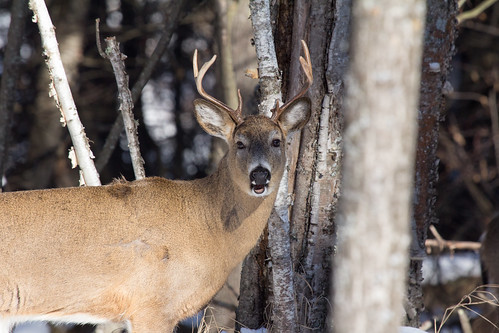 |
| This and six other deer walked past us in the woods behind the alley |
Right as we were growing discouraged, from the road above, one
of my birding friends spotted me and drove down to the alley to tell us about a
saw-whet owl he’d seen just a few blocks away. If I were to come up with a top
ten list of my favorite birders in the world, Jim Lind would
definitely be on it. He’s a great and generous birder who produces our
area’s weekly rare bird reports and compiles the Duluth Christmas Bird Count. In years like this, Jim spends his free time searching out good
birds in Two Harbors, and obviously goes out of his way to help other birders see them. And he has the
best Boreal Owl Karma of anyone in the known universe. He hadn’t spotted one yet
in Two Harbors on this Superb Owl Sunday, but the even tinier owl he’d spotted
a little while before was a great sighting. We chatted for a few minutes, until
he had to be going and we were ready to move on for the Saw-whet. We said our
goodbyes, and right as he was turning away, his eyes locked on a Boreal Owl
only about 15 feet away! Right there in the open, right beside us!
 |
| See what Jim Lind found? Right next to us!! Was the little owl there all along? |
The bird was alert, so focused on searching for the sounds of small mammals that s/he ignored us. When Jim moved on, I kept photographing the little thing.
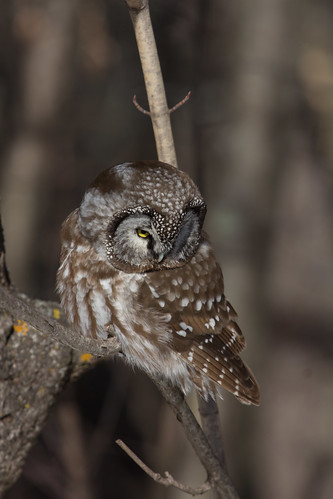 |
 |
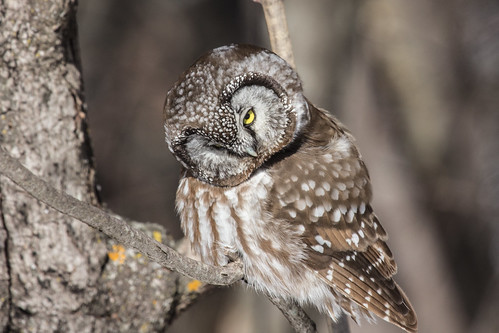 |
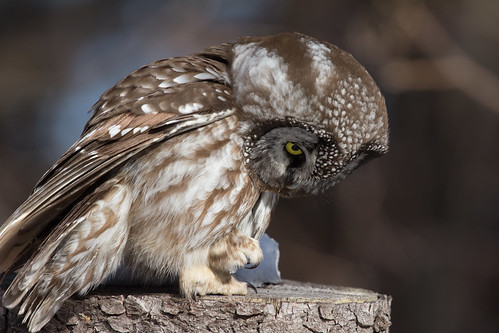 |
| The left foot appears to be injured, though s/he managed to catch and carry a shrew. |
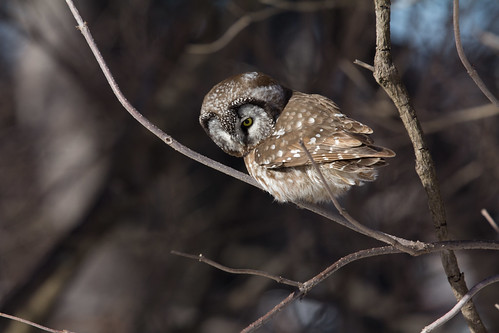 |
 |
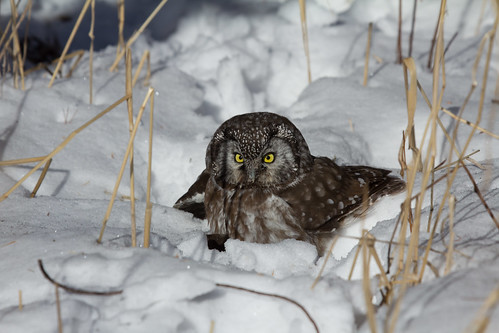 |
 |
| This chickadee was saying several naughty words! |
The Boreal Owl took off, carrying a nice hot lunch with him/her, and dropped
down on the ground behind a fallen log under a tangle of branches to try to eat
in peace. Russ and I walked away in great relief that the little mite wouldn’t
spend the day hungry.
 |
| Going off to eat in peace! |
If this 20-minute encounter with a Boreal Owl wasn’t enough,
we went to the spot where Jim Lind’s Saw-whet Owl was spending the day. That
little guy was roosting on an exposed branch, carefully keeping both eyes closed
to avoid notice by chickadees. Some people spent last evening watching a flock
of ravens playing football, but not us. We’d already experienced the best
Superb Owl Sunday ever.
 |
| Northern Saw-whet Owl |
Total miles for day: 65. New species bringing total for year to 188:
- Boreal Owl
- Northern Saw-whet Owl
Sunday, February 3, 2013
February 2: Duluth Audubon field trip to the Sax-Zim Bog
Below zero temperatures tried to put the kibosh on Duluth Audubon's annual Sax-Zim Bog field trip. The temperature in double digits below zero kept our bus from starting. While things were still in flux, we had a quick but delicious and hot breakfast at Perkins, and then decided to carpool. That was fun! I rode with a lovely couple named Charlie and Diana, with another fun birder, Elsa, along in our car as well. Elsa picked out our first bird of the day! Not quite a real one, but even an owl decoy can be fun to see.
The real birds we had in the bog were splendid! We started out at the community center, wandered up toward Owl Avenue and the large feeding station Sparky Stensaas and the Friends of Sax-Zim Bog set up. It's become a great stop!! From there we worked up to the Admiral Road feeders, then back to the Community Center, on to the Little Whiteface Road feeders and the Blue Spruce feeders, and home. What a great day! No owls, but the temperature warmed from -19 degrees to a right balmy +10, and we had plenty of other birds:
 |
| Our first bird of the day! Elsa spotted this owl. We didn't even mind that it was fake. |
- Ruffed Grouse
- Bald Eagle
- Rough-legged Hawk (people in some cars saw)
- Red-tailed Hawk (one along Highway 53 on the way home--I don't know if people in other cars saw this one)
- Downy Woodpecker
- Hairy Woodpecker
- Northern Shrike (not everyone got a good look at this one)
- Gray Jay (Great looks for everyone! There were five at the Admiral Road feeders!)
- Blue Jay (two were all fluffed up and looking rather unhappy first thing this morning)
- Black-billed Magpie (this would have been my first sighting of the year if only I'd seen them! But some people got a quick but very nice look.)
- American Crow
- Common Raven
- Black-capped Chickadee
- Boreal Chickadee (two at the Admiral Road feeders)
- Red-breasted Nuthatch
- White-breasted Nuthatch (only at the Blue Spruce feeders)
- Brown Creeper (one in the trees and on the ground near the Friends of Sax-Zim Bog feeders)
- European Starling
- Pine Grosbeak
- Common Redpoll
- Hoary Redpoll (ALL of my photos of these didn't turn out! But we had great looks at three different feeding stations)
- American Goldfinch (at least one with the House Sparrows and redpolls in the trees across the street from the Community Center)
- Evening Grosbeak (the only place we saw these was first thing in the morning, in trees across the street from the Community Center)
- House Sparrow (Our hopes of a "clean count" were destroyed first thing in the morning at the Community Center)
 |
| Ruffed Grouse feed on aspen buds in winter. If you look carefully, you'll see the little grippers on its toes--they help when branches are icy! |
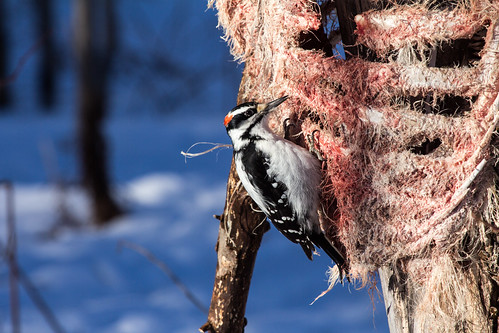 |
| Hairy Woodpecker feeding on a deer's ribcage at what I call "Sparky's feeding station" on Owl Avenue. |
 |
| Downy Woodpecker at suet. |
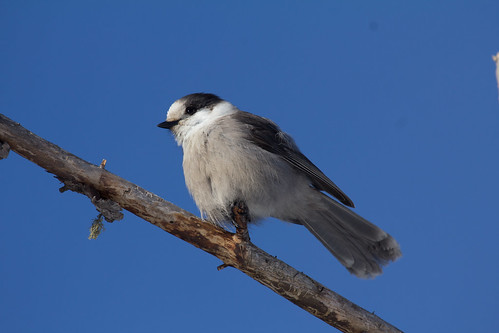 |
| Gray Jay! There were at least 5 visiting the Admiral Road feeders. |
 |
| Gray Jays look like chickadees on steroids. |
 |
| Boreal Chickadee at the Admiral Road feeders |
 |
| Boreal Chickadee |
 |
| Red-breasted Nuthatch--a pretty male |
 |
| This Brown Creeper was feeding in this tree and on the ground at the Owl Avenue feeding station. |
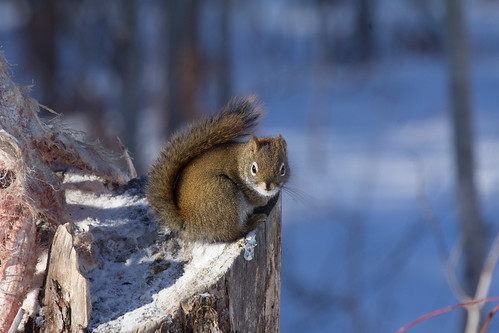 |
| I love red squirrels! |
February 1: Frozen morning with Erik Bruhnke
 |
| Steamy Lake Superior in Two Harbors |
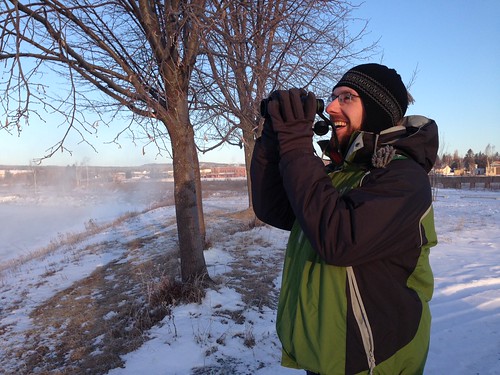 |
| Erik Bruhnke |
Saturday, February 2, 2013
January 31: First month wrap up
Home to cold little chickadee toes on my fingers! And a Red-bellied Woodpecker showed up to ease the transition from Florida to the frozen northland. Total miles on the trip: 4309 (plus the miles with Mike McDowell). Total species for the month: 186.
January 30: Wild goose chase
Greg Neise posted on facebook last night that a Barnacle Goose had been seen yesterday on Lake Bloomington in McLean County in Illinois. Today seemed like a good day for geese, especially after I saw a handful of Snow Geese (new for the year) not far from the Kentucky/Illinois border. And turns out my GPS was sending me right past an exit just a few miles from where it was seen. There was a lot of bad weather before and behind me, but when I got to Bloomington, it was just cold and blustery, not raining or snowing, so off I went on my wild goose chase.
No luck on the Barnacle Goose, but added two more geese to my year list, and met a couple of really nice birders who'd been searching for the Barnacle Goose all day. So I'm very glad I made the stop even though I got skunked on the bird I was searching for. I had a long way to go still, but made it home in one piece before 10:30. New for year, bringing my total to 186:
No luck on the Barnacle Goose, but added two more geese to my year list, and met a couple of really nice birders who'd been searching for the Barnacle Goose all day. So I'm very glad I made the stop even though I got skunked on the bird I was searching for. I had a long way to go still, but made it home in one piece before 10:30. New for year, bringing my total to 186:
- Snow Goose
- Greater White-fronted Goose
- Cackling Goose
- Gadwall
January 29: On the road again
I woke up to Northern Gannets visible from my motel balcony while I packed up, and then headed on towards home. Drove and drove and drove till I got to Kentucky.
Subscribe to:
Comments (Atom)